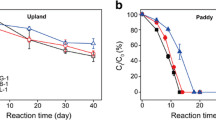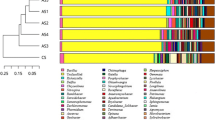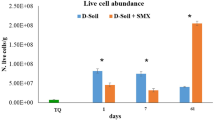Abstract
Molecular characterization based on 16s rDNA gene sequence analysis of bacterial colonies isolated from endosulfan contaminated soil showed the presence of Ochrobacterum sp, Burkholderia sp, Pseudomonas alcaligenes, Pseudomonas sp and Arthrobacter sp which degraded 57–90% of α-endosulfan and 74–94% of β-endosulfan after 7days. Whole cells of Pseudomonas sp and Pseudomonas alcaligenes showed 94 and 89% uptake of α-isomer and 86 and 89% of β-endosulfan respectively in 120 min. In Pseudomonas sp, endosulfan sulfate was the major metabolite detected during the degradation of α-isomer, with minor amount of endosulfan diol while in Pseudomonas alcaligenes endosulfan diol was the only product during α-endosulfan degradation. Whole cells of Pseudomonas sp also utilized 83% of endosulfan sulfate in 120 min. In situ applications of the defined consortium consisting of Pseudomonas alcaligenes and Pseudomonas sp (1:1) in plots contaminated with endosulfan showed that 80% of α-endosulfan and 65% of β-endosulfan was degraded after 12 weeks of incubation. Endosulfan sulfate formed during endosulfan degradation was subsequently degraded to unknown metabolites. ERIC-PCR analysis indicated 80% survival of introduced population of Pseudomonas alcaligenes and Pseudomonas sp in treated plots.
Similar content being viewed by others
References
Awasthi N, Ahuja R and Kumar A (1997) Biodegradation of endosulfan by a bacterial coculture. Bull Environ Contam Toxicol 59:928–934
Awasthi N, Ahuja R and Kumar A (2000) Factors influencing the degradation of soil-applied endosulfan isomers. Soil Biology & Biochemistry 32:1697–1705
Awasthi N, Singh A K, Jain R K, Khangarot B S and Kumar A (2003) Degradation and detoxification of endosulfan isomers by a defined co-culture of two Bacillus strains. Applied Microbiology and Biotechnology 62:279–283
Bond PL, Hugenholtz P, Keller J and Blackall LL (1995) Bacterial community structures of phosphate-removing and non-phosphate-removing activated sludges from sequencing batch reactors. Applied and Environmental Microbiology 61:1910–1916
Gi-Seok Kwon, Jang-Eok Kim, Taek-Kyum Kim, Ho-Yong Sohn, Sung-Cheol Koh, Kee-Sun Shin and Dong-Geol Kim (2002) Klebsiella pneumoniae KE-1 degrades endosulfan without formation of the toxic metabolite, endosulfan sulfate. FEMS Microbiology Letters 215:255–259
Guerin TF (2005) Natural attenuation of metabolites of a chlorinated pesticide in soil. International Journal of Environmental Studies 62:235–248
Hanahan D (1983) Studies on transformation of Escherichia coli with plasmids. J Mol Biol 166:557–580
Itahaki R F and Gil D M (1964) A micro-biuret method for estimating proteins. Anal Biochem 9:401–410
Kullman, S W and Matsumura F (1996) metabolic pathway utilized by Phanerochete chrysosporium for degradation of the cyclodiene pesticide endosulfan. Applied and Environmental Microbiology 62:593–600
Kumar S, Tamura K, and Nei M (2004) MEGA3: Integrated software for Molecular Evolutionary Genetics Analysis and sequence alignment. Briefings in Bioinformatics 5:150–163
Lee Sung-Eun, Kim Jong-Soo, Kennedy Ivan R, Park Jong-Woo, Kwon, Gi-Seok Koh, Sung-Cheo and Kim Jang-Eok (2003) Biotransformation of an Organochlorine Insecticide, Endosulfan, by Anabaena Species. J Agric Food Chem 51:1336–1340
Martens R (1976) Degradation of [8,9-14C] endosulfan by soil microorganisms. Applied and Environmental Microbiology 6:853–858
Mukherjee I and Gopal M (1994) Degradation of beta-endosulfan by Aspergillus niger. Toxicol Environ Chem 46:217–221
Rao DMR and Murty AS (1980) Persistence of endosulfan in soils. J Agric Food Chem 28:1099
Sethunathan N, Megharaj M, Chen ZL, Williams BD, Lewis G and Naidu R (2004) Algal Degradation of a Known Endocrine Disrupting Insecticide, α-Endosulfan, and Its Metabolite, Endosulfan Sulfate, in Liquid Medium and Soil. J Agric Food Chem 52:3030–3035
Siddique Tariq, Benedict C Okeke, Arshad Muhammad and Frankenberger William T Jr (2003) Enrichment and Isolation of Endosulfan-Degrading Microorganisms. J Environ Qual 32:47–54
Steiner JJ, Poklemba CJ, Fjellstrom RG and Elliott LF (1995) A rapid one tube genomic DNA extraction process for PCR and RAPD analyses. Nuc Acids Res 23:2569–2570
Sutherland TD, Horne I, Lacey MJ, Harcourt RL, Russell RJ, and Oakeshott JG (2000) Enrichment of an endosulfan-degrading mixed bacterial culture. Applied and Environmental Microbiology 66:2822–2828
Sutherland TD, Weir KM, Lacey MJ, Horne I, and Russell RJ (2002) Gene cloning and molecular characterization of a two-enzyme system catalyzing the oxidative detoxification of β-endosulfan. J Appl Microbiol 92:541–548
Versalovic J, Koeuth T and Lupski JR (1991) Distribution of repetitive DNA sequences in eubacteria and application to fingerprinting of bacterial genomes. Nucleic Acids Res 19:6823–6831
Author information
Authors and Affiliations
Corresponding author
Rights and permissions
About this article
Cite this article
Kumar, M., Lakshmi, C.V. & Khanna, S. Microbial biodiversity and in situ bioremediation of endosulfan contaminated soil. Indian J Microbiol 48, 128–133 (2008). https://doi.org/10.1007/s12088-008-0012-7
Received:
Revised:
Accepted:
Published:
Issue Date:
DOI: https://doi.org/10.1007/s12088-008-0012-7




